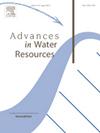Vertical textural contract (VTC) increases seawater evaporation from heterogeneous sand
IF 4.2
2区 环境科学与生态学
Q1 WATER RESOURCES
引用次数: 0
Abstract
The coupled soil texture and salinity effect on evaporation in porous systems is complex. This study investigates how vertical textural contrast (VTC) influences evaporation of artificial seawater (SW) compared to freshwater/deionized (DI) water. We conducted experiments using Hele-Shaw cells packed with a fine sand, a coarse sand, and their mixture, respectively, and monitored changes in evaporation rate and water/salt solution dynamics over 20 days. Using light transmittance to detect 2D distribution of water content and surface salt precipitation, we determined how fine/coarse textural contrast affects water transport and salt accumulation. Our findings demonstrated that VTC prolonged high-level water saturation through lateral water transfer from coarse to fine sand, which increased the evaporation rate in both SW and DI water systems. This lateral transfer was driven by differences in capillary pressure between coarse and fine sands, and SW was found to have limited effects on changing the capillary pressure difference compared to DI water systems. Notably, the increase in evaporation due to VTC was more pronounced in SW systems compared to DI systems, which was attributed to the delayed onset of salt precipitation in the fine fraction of heterogeneous chambers compared to homogeneous systems. Our results clarify the intricate mechanisms underlying saltwater evaporation in porous media and emphasize the critical control of soil textural heterogeneity and salinity in evaporation dynamics.
垂直纹理收缩(VTC)增加非均质砂的海水蒸发
土壤质地和盐度对多孔系统蒸发的耦合影响是复杂的。本研究探讨了与淡水/去离子水(DI)相比,垂直纹理对比(VTC)如何影响人工海水(SW)的蒸发。我们在Hele-Shaw细胞中分别填充细砂、粗砂及其混合物,并在20天内监测蒸发速率和水/盐溶液动力学的变化。利用透光率检测水含量和表面盐沉淀的二维分布,我们确定了细/粗纹理对比对水分输送和盐积累的影响。我们的研究结果表明,VTC通过从粗砂到细砂的横向水转移延长了高含水饱和度,这增加了SW和DI水系统的蒸发速率。这种横向转移是由粗砂和细砂之间的毛管压力差异驱动的,与去水系统相比,SW对改变毛管压力差的影响有限。值得注意的是,由于VTC导致的蒸发增加在SW系统中比在DI系统中更为明显,这是由于与均质系统相比,非均质腔中精细部分的盐沉淀延迟发生。我们的研究结果阐明了多孔介质中盐水蒸发的复杂机制,并强调了蒸发动力学中土壤质地异质性和盐度的关键控制。
本文章由计算机程序翻译,如有差异,请以英文原文为准。
求助全文
约1分钟内获得全文
求助全文
来源期刊

Advances in Water Resources
环境科学-水资源
CiteScore
9.40
自引率
6.40%
发文量
171
审稿时长
36 days
期刊介绍:
Advances in Water Resources provides a forum for the presentation of fundamental scientific advances in the understanding of water resources systems. The scope of Advances in Water Resources includes any combination of theoretical, computational, and experimental approaches used to advance fundamental understanding of surface or subsurface water resources systems or the interaction of these systems with the atmosphere, geosphere, biosphere, and human societies. Manuscripts involving case studies that do not attempt to reach broader conclusions, research on engineering design, applied hydraulics, or water quality and treatment, as well as applications of existing knowledge that do not advance fundamental understanding of hydrological processes, are not appropriate for Advances in Water Resources.
Examples of appropriate topical areas that will be considered include the following:
• Surface and subsurface hydrology
• Hydrometeorology
• Environmental fluid dynamics
• Ecohydrology and ecohydrodynamics
• Multiphase transport phenomena in porous media
• Fluid flow and species transport and reaction processes
 求助内容:
求助内容: 应助结果提醒方式:
应助结果提醒方式:


